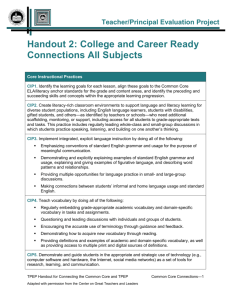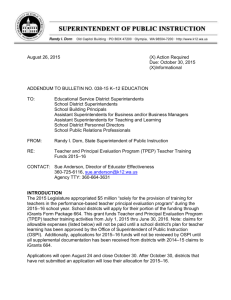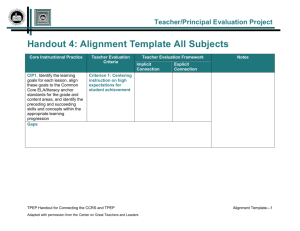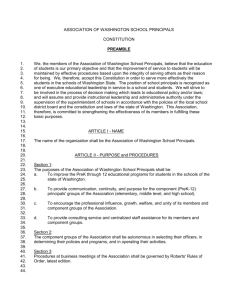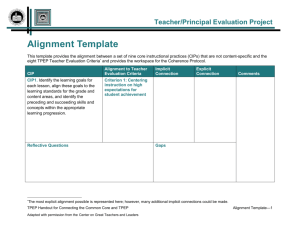Presentation - Washington Association of School Administrators
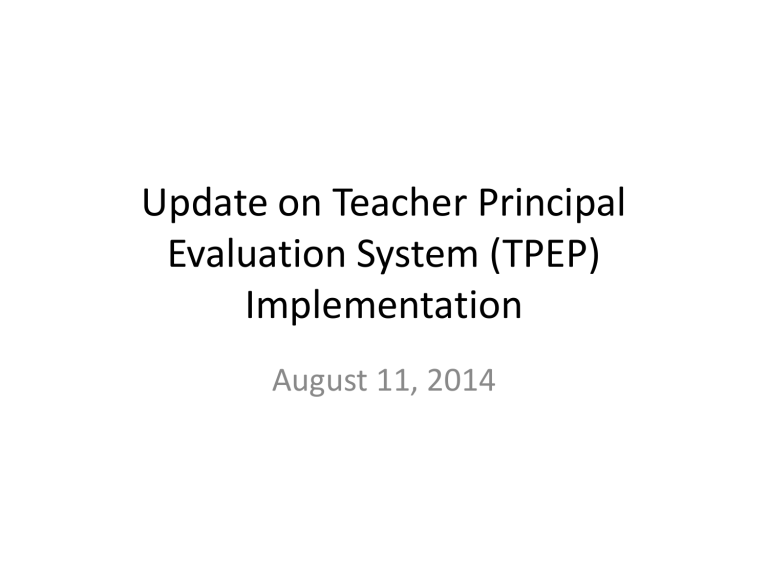
Update on Teacher Principal
Evaluation System (TPEP)
Implementation
August 11, 2014
Background: Why did Washington change the evaluation laws?
• Washington is one of 31 states to change educator evaluation laws over the past three years.
• The Washington State Legislature passed E2SSB
6696 in 2010 that created the Teacher and
Principal Evaluation Pilot (TPEP) and TPEP
Steering Committee.
• Law is applicable to certificated classroom teachers and certificated principals and assistant principals.
Background: What is the TPEP
Steering Committee?
• The original legislation called for:
“OSPI, in collaboration with state associations representing teachers, principals, administrators, and parents” to oversee the work of the TPEP pilots.
• In ESSB 5895, school board members were added and the legislation notes that this group shall be called “the steering committee.”
The original five TPEP Steering Committee organizations (OSPI,
WEA, AWSP, WASA, and WSPTA) were joined by WSSDA in May,
2011.
Background: How was the revised evaluation system developed?
• The revised evaluation system was developed by the nine pilot sites and the TPEP Steering
Committee. The experience and voice of the pilot site practitioners was vitally important in developing rubrics, rules, and procedures for the revised system.
Background: Have there been any updates to the original 2010 legislation?
• During the 2012 legislative session, educator evaluation was taken up once more by the legislature and ESSB 5895 passed and was signed into law June 7, 2012. ESSB 5895 amends RCW 28A.405.100.
Background: What policies are set at the state level and what flexibility do districts have?
• The Decision Matrix (PDF) identifies the various aspects of the revised evaluation system and defines the state and local decision-making process.
• http://tpep-wa.org/the-model/state-vs-localdecision-matrix/
Employee Groups: WAC 392-191A-030
• Certificated Teacher:
Those that provide “academically-focused instruction to students” should be considered in the revised evaluation system
• Certificated Principal/Assistant Principal:
Consideration and discussion at a local level should focus on the roles/responsibilities of the employee as it relates to the new criteria and frameworks.
Implementation:
How will a school board make informed decisions about the details of the evaluation system in order to adopt a schedule for implementation?
• The legislation requires:
School district board of directors to adopt an implementation schedule beginning in 2013–14.
All provisional and probationary classroom teachers begin in 2013–14 on a comprehensive evaluation.
All principals in their first three consecutive years, those judged unsatisfactory in 2012-13, or those in their first year in a district require a comprehensive principal evaluation in 2013–14.
All classroom teachers, principals, and assistant principals are evaluated under the revised system no later than
2015–16.
Nothing prevents earlier transition
Implementation:
What authority do school boards have in the revised evaluation system?
• According to the legislation, the two primary responsibilities school directors have are to establish their districts’ evaluative criteria
(containing, at a minimum, the criteria established by OSPI) and a district implementation schedule
Implementation:
Are there guidelines or recommendations on developing an implementation schedule?
• The implementation recommendation allows for:
More intentional rater agreement training during the first years of implementation.
More reasonable accommodation for the variety of teacher-principal caseload numbers.
More careful evaluations of provisional status teachers that will be on a comprehensive evaluation in the first year of implementation
Evaluation Components:
Teacher Criteria
• Expectations • Learning Environment
• Instruction
• Differentiation
• Content Knowledge
• Assessment
• Families and
Community
• Professional Practice
Evaluation Components:
Principal Criteria
• School Culture • Alignment
• Closing the
Achievement Gap
• School Safety
• Data-Driven Plan
• Monitoring
Instructional Practices
• Managing Resources
• Partnering with School
Community
Evaluation Components:
Approved Frameworks
• Teacher: Instructional Frameworks
CEL 5D+
Danielson
Marzano
• Principal: Leadership Frameworks
AWSP
Marzano
Student Growth
• RCW 28A.405.100 defines as:
“change in achievement between two points in time”
• WAC 392-191A-080 states:
“more than one measure of student growth data must be used in scoring the student growth rubrics”
Measures include:
– classroom-based tools
– school-based tools
– district-based tools
– state-based tools
Student Growth:
What are the three components of student growth for teachers and how they are different for each criterion?
TFOrhe components are:
SG 3.1
– Establish Student Growth Goals
Refers to individual or subgroups of students (achievement/opportunity gap)
SG 3.2
– Achievement of Student Growth Goals
Refers to individual or subgroups of students (achievement/opportunity gap)
SG 6.1
– Establish Student Growth Goals using Multiple Student Data Elements
Refers to the whole class based on appropriate standards and aligned to school and district goals
SG 6.2
– Achievement of Student Growth Goals
Refers to the whole class based on appropriate standards and aligned to school and district goals
SG 81.
– Establish Team Student Growth Goals
Refers to the teacher as part of a grade-level, content area, or other school or district team
Student Growth: What are the three components of student growth for principals and how they are different for each criterion?
• SG 3 – Provides evidence of student growth that results from the school improvement planning process.
• SG 5 – Provides evidence of student growth of selected teachers.
• SG 8 – Provides evidence of growth in student learning.
Student Growth: How should student growth be evaluated?
• The principal and the teacher should sit down to discuss available evidence that demonstrates progress towards goals. The discussion should be based on the goal(s) set by the teacher and approved by the principal as well as on student work and/or performance that demonstrates progress towards that goal. Some districts have defined “growth for most students” and “high evidence of growth” but the context of each classroom is critical to every decision.
Student Growth: Do student growth goals for teachers need to align with principal goals or the school improvement plan?
• Most importantly, goals must be meaningful and relevant to the teacher. The 6.1 student growth rubric for
Distinguished in 6.1 states “These whole classroom goals align to school goal(s).” The principal student growth rubric asks principals to “provide evidence of student growth that result from the school improvement planning process (SG3) and provide evidence of growth in student learning.” While it makes perfect sense that all boats are pulling in the same direction, it is not required that the teacher goals match the principal or school goals unless the bargaining agreement specifies that as a local requirement.
Student Growth:
How does the federal waiver change Washington’s approach to student growth?
• The Legislature did not pass a bill so there is no change to TPEP. Washington’s student growth process and rubrics remain the same.
Summative Performance Rating Tiers
• Distinguished
• Proficient
• Basic
• Unsatisfactory
July 2014 Report to the Legislature:
Key Findings
• Understanding of teacher and principal evaluation requirements through professional development is increasing
Continued training is needed
• Understanding of teacher and principal frameworks through professional development is increasing
Ongoing training is needed
Understanding of student growth and formative assessment is needed
• Time is a precious resource!
• Common Core State Standards connections are still not clear
July 2014 Report to the Legislature:
Key Recommendations
• More professional development
For teachers
For principals
For school directors
• Assess level of understanding of teachers and principals
• Better communication on teacher and principal evaluation
• Support the culture shift in the primary role of evaluators as instructional leader or coaches
• Further study on the effect and outcomes of the evaluation system
• Develop additional training and resources making connections between TPEP and Common Core
Plans for 2014-15
• What happens when an evaluator moves to a district with another framework?
Evaluators must have training on the framework they are currently using – when evaluators move to a district with a framework that is new to them, they need Stage 1 and
Stage 2 training on the new framework. ESDs will coordinate instructional framework training; AWSP and LSI will coordinate leadership training.
Plans for 2014-15
• Is there funding for framework training in 2014-
2015?
TPEP is funded for 2014-15. ESDs will provide regional training on the instructional frameworks that is free to participants. AWSP and LSI will do the same for leadership framework training. OSPI will continue to publish a list of approved framework trainers for districts that want to contract with framework specialists directly. School districts will have a small allocation for teacher training (approximately $80 per teacher).
The funds will be administered through iGrants. OSPI will open iGrant
664 in August. Approved teacher training activities that occur July 1,
2014 – June 30, 2015 will be reimbursed up to the district’s maximum allocation.
TPEP Website
• RCWs, WACs and FAQs
• Documented development history
• State and Local decisions
• Map and list of local framework choices
• Rubrics and scoring guidance
• Online training modules
• And more….. http://tpep-wa.org
